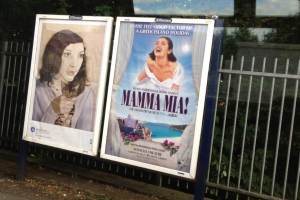Last week I was standing at the platform at London Euston Station when I noticed something odd. A man who had been rushing past suddenly stopped to look at an advertisement. He was looking at it for about 45 seconds before I became curious and turned to see just what caught his attention.
The image was not an advertisement per se, but a reproduction of Constable’s painting of Salisbury Cathedral from the Meadows. For those who haven’t seen the picture, it’s a classic Romantic landscape: the English Gothic spire reaches towards the crowded grey sky; the large clouds and windswept trees dwarf the human figures in the foreground. It’s a sublime image about the power of nature and, through the church’s reaching spire, its connection to a higher power.
The poster is part of scheme called ‘Art Everywhere’. Richard Reed, the entrepreneur behind the project, has, in his own words, attempted to ‘turn the UK into the world’s largest art gallery.’ In order to do this, he partnered up with Tate and The Art Fund to raise money to purchase advertising space across the country. Today, billboards all over the UK house some of Britain’s most famous works of art, from Romantic Constables to contemporary Hirsts.

Lucian Freud meets Mamma Mia
I found it interesting that the man at Euston was so taken with the poster. Paintings in museums still possess the aura of ‘the original’, but digital technologies have made reproductions cheap, common, and I thought that the works reproduced for ‘Art Everywhere’ would become just another set of advertisements. Yet he stopped, in the middle of his morning commute, in order to contemplate a timeless work of art. Perhaps it is possible for a reproduction to have the aura of an original, even on a busy train platform.
One would imagine that ‘Art Everywhere’ was designed to produce the scene that I witnessed this week: to make sure that those of us who are too busy to go to museums understand art’s value. Certainly, Richard Reed’s scheme makes the high street slightly prettier, but is this the best way to interact with these images? Perhaps the man staring at the Constable was not only acknowledging its beauty, but also asking ‘Why is this here?’ It’s curious to see a Constable painting next to a Vodafone advert.
If ‘Art Everywhere’ does anything, it forces us to think about what the differences are between these two types of images and why they both have a powerful effect on us.
Art Everywhere ran from 12–25 August 2013 throughout the UK.

Art Everywhere
Art Everywhere? Something to ponder on the daily commute
Share
Last week I was standing at the platform at London Euston Station when I noticed something odd. A man who had been rushing past suddenly stopped to look at an advertisement. He was looking at it for about 45 seconds before I became curious and turned to see just what caught his attention.
The image was not an advertisement per se, but a reproduction of Constable’s painting of Salisbury Cathedral from the Meadows. For those who haven’t seen the picture, it’s a classic Romantic landscape: the English Gothic spire reaches towards the crowded grey sky; the large clouds and windswept trees dwarf the human figures in the foreground. It’s a sublime image about the power of nature and, through the church’s reaching spire, its connection to a higher power.
The poster is part of scheme called ‘Art Everywhere’. Richard Reed, the entrepreneur behind the project, has, in his own words, attempted to ‘turn the UK into the world’s largest art gallery.’ In order to do this, he partnered up with Tate and The Art Fund to raise money to purchase advertising space across the country. Today, billboards all over the UK house some of Britain’s most famous works of art, from Romantic Constables to contemporary Hirsts.
Lucian Freud meets Mamma Mia
I found it interesting that the man at Euston was so taken with the poster. Paintings in museums still possess the aura of ‘the original’, but digital technologies have made reproductions cheap, common, and I thought that the works reproduced for ‘Art Everywhere’ would become just another set of advertisements. Yet he stopped, in the middle of his morning commute, in order to contemplate a timeless work of art. Perhaps it is possible for a reproduction to have the aura of an original, even on a busy train platform.
One would imagine that ‘Art Everywhere’ was designed to produce the scene that I witnessed this week: to make sure that those of us who are too busy to go to museums understand art’s value. Certainly, Richard Reed’s scheme makes the high street slightly prettier, but is this the best way to interact with these images? Perhaps the man staring at the Constable was not only acknowledging its beauty, but also asking ‘Why is this here?’ It’s curious to see a Constable painting next to a Vodafone advert.
If ‘Art Everywhere’ does anything, it forces us to think about what the differences are between these two types of images and why they both have a powerful effect on us.
Art Everywhere ran from 12–25 August 2013 throughout the UK.
Share
Recommended for you
Review: The Art of Music
An exhibition on Vermeer and music at London’s National Gallery is a harmonious triumph
Italy’s Digital Ruins
When will Italian museums do something to improve their websites?
Web Editor’s Welcome
There’s a lot of talk about the challenges that digital publishing poses to print; less about how they might complement each other